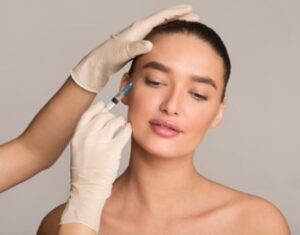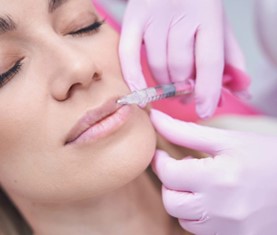- Follow us on:
- Opening Hours:
- Monday - Friday: 09:00 - 17:30
As a GP, Dr Aisha is able to prescribe Botulinum Toxin (commonly known as Botox) and use her knowledge of facial anatomy in order to safely inject the areas required. The injection works by temporarily relaxing the facial muscles whilst still maintaining natural movement and expression. Specific areas that can be treated include forehead lines, crow’s feet, bunny lines and chin dimpling. Botox can also be used to give a natural neck lift, treat hyperhidrosis (excessive sweating) of the underarms and to treat teeth clenching.

Dr Aisha uses Restylane dermal fillers, which are a non-animal, hyaluronic acid-based gel used to add volume and diminish the appearance of lines and wrinkles. As we age, both the facial skin and deeper layers of the skin lose elasticity, contributing to the signs of ageing. Dermal fillers can be used to rejuvenate and enhance a youthful facial fullness; as with all treatments, Dr Aisha’s aim is to always maintain a natural beauty and maintain expression. This is a long-lasting but not permanent treatment where results can be seen instantly. Specific areas that Dr Aisha will be able to treat include the cheeks and mid-face, nasolabial folds and marionette lines and lips. Lip treatment includes the injection of a local anaesthetic for a complete numbing effect.

Skin booster treatment involves injections of hyaluronic acid, designed to deliver deep skin hydration. It is not a filler and does not give any volume to the face, but is in fact a soft, gel-like substance. Hyaluronic acid is an amazing humectant, which means it draws water to the surface of our skin. Each molecule of HA can bind and hold 1000 times its own weight in water. It occurs naturally in the skin, but levels reduce with age, which is what causes skin to appear rougher or with a drier texture. Microinjections of deeply hydrating hyaluronic acid restore the moisture in the skin, which improves its elasticity, firmness and radiance. It is sometimes described as an ‘injectable moisturiser’. However, unlike just a moisturiser that you apply at home, the injections can penetrate much deeper and last longer. In contrast to fillers, Skin Boosters help improve collagen and elastin. Another key benefit of skin boosters is that they are particularly good at improving hydration and can be used to treat many different skin areas and skin types. Most common areas are the face, followed by the neck, chest and the hands. How often will I need skin boosters? Restylane Skinboosters are typically administered over the course of 2-3 treatment sessions, 2–4 weeks apart, to restore your skin’s elasticity and smoothness in a gradual way. After this, Dr Aisha recommends regular maintenance sessions (approximately every 6 months) to ensure lasting results. Clinical studies prove the lasting impact of Restylane Skinboosters treatment with improvement in skin elasticity of the face and hands for up to 12 months after the initial treatment.
Polynucleotide treatment works with the body’s DNA to promote cellular regeneration. This innovative treatment stimulates collagen and elastin production by encouraging the body’s natural regenerative processes.
Polynucleotide therapy is used for:
Conventional tear trough fillers rely on hyaluronic acid and primarily add volume, which can cause potential prolonged swelling and puffiness. In comparison, Polynucleotide treatment adopts a more holistic approach, enhancing the under-eye skin’s quality by encouraging the body’s natural regenerative processes. Polynucleotide eye treatments will not ‘fill’ the under-eye area and will not cause puffiness or migration of the product. The focus is on achieving natural-looking results that enhance the skin’s elasticity, reduce pigmentation and minimise fine lines and wrinkles.
The effects of Polymononucleotide Eyes tend to last 6-9 months after two treatments. Dr Aisha recommends two treatments, 4 weeks apart, to achieve optimal results and then a top-up session every 6-9 months to sustain the results. Unlike dermal fillers, which offer instant results, polynucleotide treatment requires some patience, with the best results seen 2-3 months following treatment.
The Polynucleotide treatment is minimally invasive, commonly, clients experience swelling for 24 hours after treatment. You can expect minimal downtime, allowing you to return to your daily activities the day after treatment.
While the idea of undergoing a cosmetic procedure around the delicate under-eye area can be intimidating, Polynucleotide treatment ensures both safety and comfort for patients. The treatment is carried out using a cannula, similar to traditional fillers, minimising discomfort and reducing the risk of bruising. Although the procedure may cause some mild stinging, it is generally well-tolerated and over within minutes.
We’re delighted to introduce a new treatment now available at Selsdon Dental Surgery – Microneedling with Dermapen, performed by our experienced clinician, Dr Aisha.
Microneedling is a minimally invasive procedure that uses a device equipped with ultra-fine needles to create tiny, controlled micro-injuries to the skin or scalp. These micro-injuries kickstart your body’s natural healing response, boosting collagen and elastin production, which leads to firmer, smoother, and healthier skin, or thicker, stronger hair when applied to the scalp.
For the Face:
For the Scalp:
Pricing: